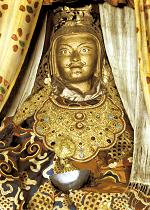Looks Like Me: Difference between revisions
No edit summary |
No edit summary |
||
| (6 intermediate revisions by 3 users not shown) | |||
| Line 1: | Line 1: | ||
'''‘Looks Like Me’''' (Tib. ''guru ngadrama'') | [[Image:Guru ngadrama.JPG|frame|The famous 'Looks Like Me' statue]] | ||
'''‘Looks Like Me’''' (Tib. ''guru ngadrama'', [[Wyl.]] ''gu ru nga 'dra ma'') — this is an image of [[Padmasambhava]] which was made from life and blessed by him in the eighth century in Tibet. It is believed that on seeing this statue at [[Samyé]], he remarked, “It looks like me,” and then blessed it, saying, “Now it is the same as me!” | |||
Together with [[Jamyang Khyentse Chökyi Lodrö]], [[Sogyal Rinpoche]] performed a hundred thousand [[tsok]] offerings in front of this image when they stayed in Samyé for more than a month on their way to India. | |||
The original black and white photograph was taken by the Queen Mother of Sikkim [[Gyalyum Kunzang Dechen Tsomo Namgyal]]. It was then computer enhanced according to the advice of lamas who had seen the original, which was sadly destroyed during the Cultural Revolution. | |||
[[Category:Statues and Images]] | [[Category:Statues and Images]] | ||
[[Category:Guru Rinpoche]] | |||
Latest revision as of 16:55, 18 November 2019

‘Looks Like Me’ (Tib. guru ngadrama, Wyl. gu ru nga 'dra ma) — this is an image of Padmasambhava which was made from life and blessed by him in the eighth century in Tibet. It is believed that on seeing this statue at Samyé, he remarked, “It looks like me,” and then blessed it, saying, “Now it is the same as me!”
Together with Jamyang Khyentse Chökyi Lodrö, Sogyal Rinpoche performed a hundred thousand tsok offerings in front of this image when they stayed in Samyé for more than a month on their way to India.
The original black and white photograph was taken by the Queen Mother of Sikkim Gyalyum Kunzang Dechen Tsomo Namgyal. It was then computer enhanced according to the advice of lamas who had seen the original, which was sadly destroyed during the Cultural Revolution.